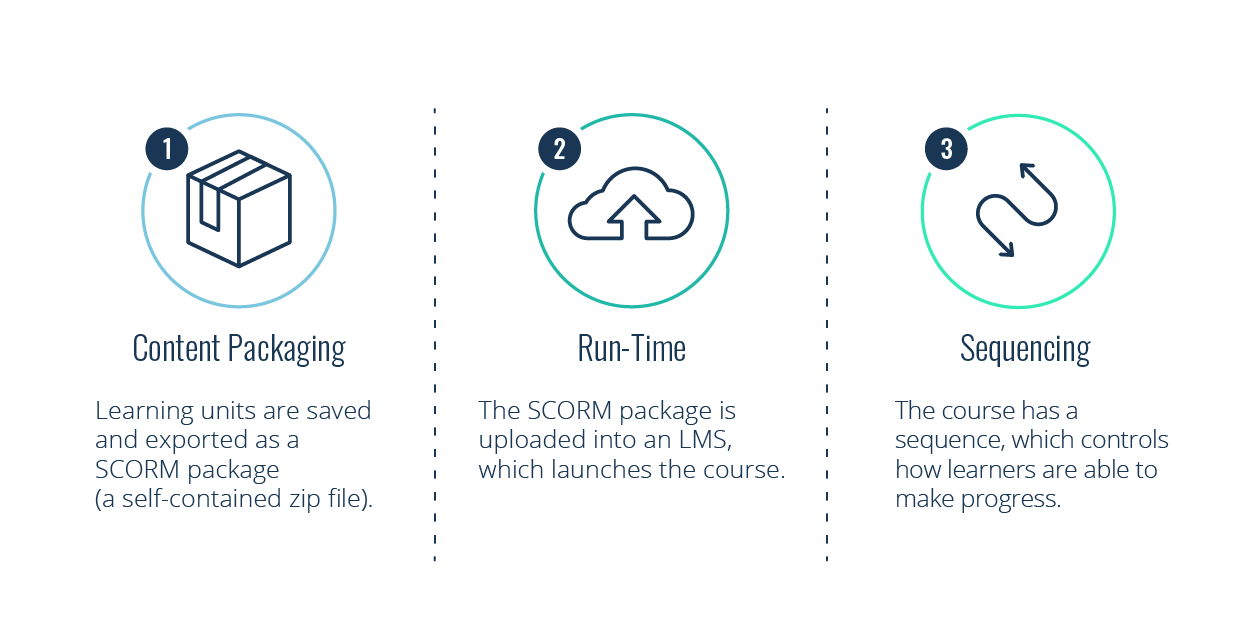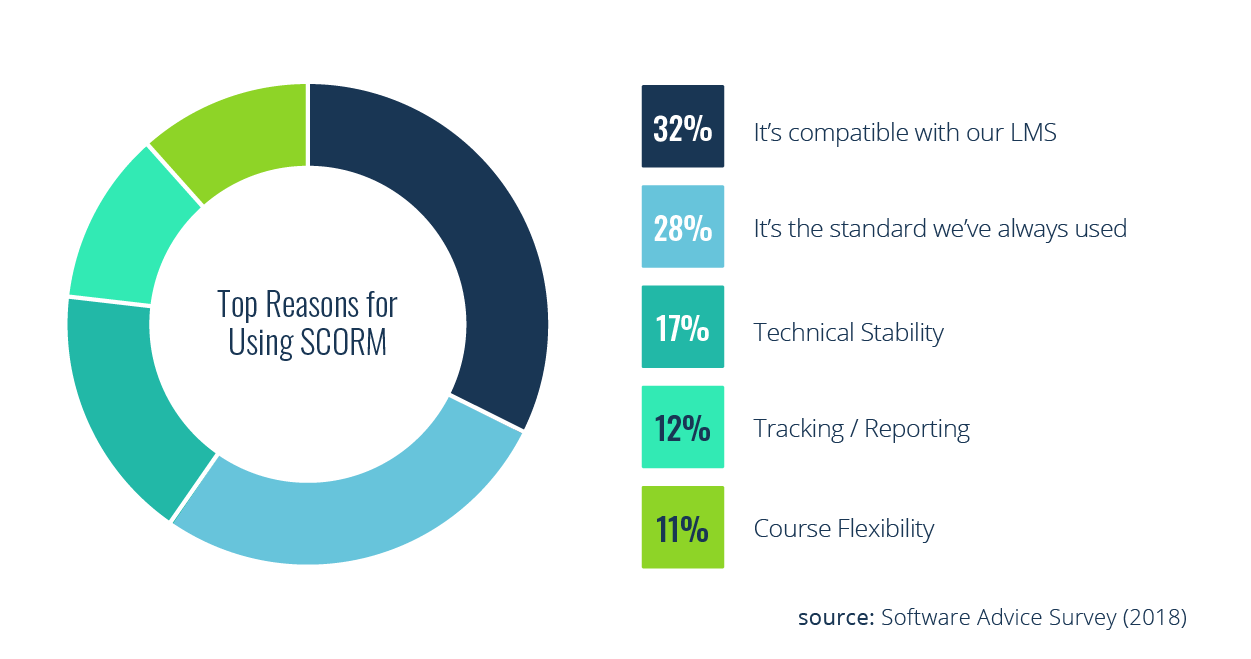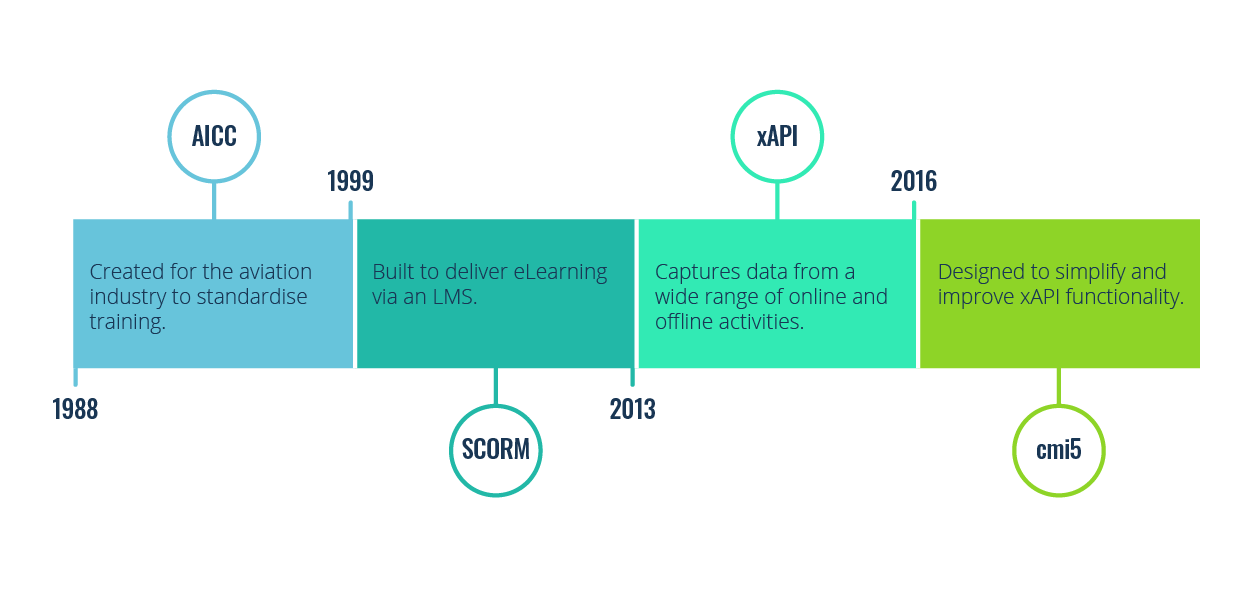 If you have any involvement whatsoever with online learning, you’re going to need to wrap your head around SCORM.
If you have any involvement whatsoever with online learning, you’re going to need to wrap your head around SCORM.
Whether you’re dealing with eLearning software, eLearning content creation or the administration of a learning management system, you’ll have SCORM to thank for making things run smoothly.
Whilst it has competition, SCORM remains the most popular eLearning compliance standard. In fact, in terms of popularity, SCORM is the equivalent of Taylor Swift. It’s totally ubiquitous.
On the other hand, xAPI is a struggling indie musician waiting to hit it big and AICC is an aging rockstar who is on their way out.
With that said, let’s take a closer look at SCORM to discover how it became the all-encompassing force it is today!
- What is SCORM?
- The History of SCORM
- How does SCORM work?
- Benefits of SCORM
- What is the Future of SCORM?
- Is it Time to Replace SCORM?
- Modern Alternatives to SCORM
What Is SCORM?
SCORM stands for Shareable Content Object Reference Model.
Phew! Sounds too technical? Let’s break it down!
‘Shareable Content Objects’ or ‘SCOs’ refer to the different learning units which can be shared and reused across different systems. ‘Reference Model’ indicates how the SCORM model references existing standards in the industry.
SCORM provides a list of technical specifications for eLearning content. If all content is made to meet these criteria, then it becomes much easier to provide a matching system to host and deliver it.
Think of a child’s shape sorting toy. When you have a large number of shapes to fit in, it can be difficult to find a match. No matter how hard you try to fit a square peg into a round hole, it simply won’t work!
But if all of the pegs and holes are triangles, then you can fit any peg into any hole. This is the premise behind SCORM. It drives compatibility between content (the peg) and learning platforms (the sorting toy).
There are currently two specifications. These are SCORM 1.2 and SCORM 2004. This means that there are only two shapes to fit. As long as your content and your LMS are built to comply with the same specification, then they should work seamlessly together.
This means that your content will display properly for your learners and you’ll be able to track the results as they interact with it. Here’s a video we’ve prepared to help you learn more about SCORM!
The History of SCORM
Cast your mind back to the 1990s. This was the decade which saw The Spice Girls, Friends, Titanic and of course, an explosion in the use of online training!
But there was a problem. There was no agreed structure for eLearning at the time. Every piece of content had to be tailored for a specific delivery system. This proved too costly, and meant that if an organisation wanted to switch to a new learning platform, all of their content would suddenly become obsolete!
Eventually in 1999, the United States Department of Defense decided that enough was enough. They called for eLearning production to be standardised, in what we would like to retroactively name Operation Desert SCORM.
The Advanced Distributed Learning Initiative (ADL) answered the call, and developed SCORM.
Initially, SCORM faced some competition from another compliance standard, AICC. Eventually however, it was clear that it would come to dominate the market. True enough, it is now the most commonly used content standard in the online learning landscape!
How Does SCORM Work?
To demonstrate how SCORM works, let’s set up this scenario.
Let’s say you want to implement an eLearning course for your retail team. To do this, you will need two ingredients: an authoring tool and an LMS (or another learning platform of your choice).
Your authoring tool will assist you in whipping up a full-blown training course featuring multiple eLearning units. Once ready, it’s time to zip these up into a scrumptious SCORM file.
This file can then be imported onto your LMS. Your learning platform will then be responsible for unwrapping the SCORM file, and serving it to your crew of hungry learners.
Efficient, right? But to make this happen, you will need to ensure that your eLearning course and LMS can speak the same language.
This is exactly what SCORM does. It governs this process by creating a set of ‘specification rules’ to which all content must abide. This is what we call SCORM compliance.
When an eLearning module is SCORM-compliant, it can be easily transferred and matched to a SCORM-compliant LMS. And these days, most LMSs are compatible with SCORM. After all, it has been the preeminent eLearning standard since the dawn of the new millennium.
The Three Components of SCORM
Now here’s where we get slightly technical. SCORM is a technical specification after all! But don’t worry, we’ll make it easy for you. To better appreciate how SCORM works, let’s have a look at its three sub-components:

1. Content Packaging
The first component of SCORM specifies how content should be packaged and described. This will involve the creation of a manifest file with associated learning object metadata. This is an XML file that completely describes the content.
This stage usually involves the use of a SCORM-compliant course authoring tool. The good news is, most content authoring tools are SCORM-compliant. That means they’ll take care of the technicalities.
For instance, Growth Engineering’s authoring tool follows SCORM specifications. What’s more, it lets you easily design online course modules filled with interactive media, video and gamified quizzes.
Once you’ve created your learning content, you can then bundle it up in a SCORM package. This package is a self-contained zip file, also known as a Package Interchange File (PIF). It contains all the files needed in order to deliver and communicate your eLearning course to a compliant LMS.
2. Run-Time
This component of SCORM specifies how content should be launched and how it will communicate with your LMS. Simply put, this is the specification that will help get your SCORM package running on your learning system!
To see how this works, you could picture the SCORM package as a shipping container full of eLearning units. The LMS is the boat that holds the container.
When a SCORM module is uploaded, it tells the LMS which data to receive. Once your learners board the ship, your LMS will use this data to launch the course in a web browser.
Voilà!
But the communication does not stop there. Once the content is launched, your LMS and SCORM packages will continue to work together to track and report on a range of learning data.
The result? You’ll now be able to track the following data on your LMS:
- Time spent on the course
- Learners’ progress at every point of the course
- Learners’ objectives and scores
- Test and quiz results
- Pageviews and dwell time
3. Sequencing
The third component of SCORM deals with the structure and sequence of events within a compliant file.
In other words, it specifies the sequence of learning activities that users must engage with throughout the course. The process of sequencing starts when the course is launched on your LMS.
As such, if you like control, then you’ll appreciate this one. After all, this SCORM feature enables you to define the ‘rules’ of how your learners must interact with your eLearning content. You can set these rules early on when creating the SCORM package.
Are your learners able to skip ahead? Or do they have to follow a pre-set path? Can they revisit previous content? Thanks to SCORM, you now have more control over these decisions.
Here’s an example. Let’s say Anna from Customer Success has just finished an eLearning module — Social Learning 101. Behind the scenes, SCORM specifies to the LMS which activities Anna should complete next. As a result, Anna is presented with a ‘Next’ button, which will then direct her to a relevant follow-up module (for instance, Social Learning 102).
Benefits of SCORM
As mentioned earlier, SCORM is now the most widely used specification for eLearning. So if your training content is SCORM compliant, you can guarantee it’s compatibility with any LMS! In fact, a survey by Software Advice shows that around 62% of businesses use SCORM in their LMS!
Another benefit is that once your SCORM package has been created, you can then deploy it on different systems without having to alter it. This helps you to scale your learning library with great ease and at reduced cost.
What’s more, most authoring tools lets you easily create SCORM courses with little technical knowledge required. This makes creating and sharing your courses on our LMS a breeze!
SCORM’s reporting capabilities also let you track the progress of your learners. This data can provide you with useful insights. As a result, you can fine tune your learning programme and start producing even better outcomes.

However, as you can see from the diagram above, most learning professionals use SCORM because of a lack of viable alternatives. SCORM is mostly used because ‘that’s the way things are done’. So, what does this suggest about the future of this compliance standard?
What is the Future of SCORM?
SCORM has done a fantastic job, considering that it’s more than twenty years old! At this point however, it’s become clear that it could do with a bit of a facelift…
Back in 2010, the ADL issued a call for research into the next generation of SCORM. Rustici Software answered this call and their work would eventually lead to the creation of the Experience API, better known as xAPI or Tin Can API. This first version of xAPI was released in April 2013.
This standard builds on SCORM and adds more functionality. For instance, it empowers learning professionals to track informal learning experiences — the kind of learning that takes place outside of an LMS. It also makes learning records more mobile, so that learners can take their data with them when they change schools or jobs.
Though xAPI is up and running, it will take a long time to dethrone the behemoth that is SCORM. So expect to see the incumbent supported by both LMSs and authoring tools for many years to come!
Is it Time to Replace SCORM?
Is it finally time for SCORM, the specification superstar of the noughties, to move over for modern learning standards? Here’s the case for considering other alternatives!
1. It’s Safe (Too Safe!)
SCORM has failed to evolve with the times. The last SCORM version was released in 2004! To put this into perspective, that’s the same year that Mark Zuckerberg created Facebook. Just think about how much that platform has evolved over time (for better and for worse).
And yet, many L&D professionals remain reluctant to move on to something new and improved. Thousands of online courses continue to be created using the SCORM standard and many authoring tools solely support SCORM-compliant learning technology.
SCORM may feel as cosy and familiar as that college hoodie you can’t throw out, but safe is not always good. It’s like being in a relationship that is okay but not awesome.
This leaves many L&D pros thinking: “SCORM is fine for now”, “We’re used to it” and “We know how it works”. Yet, something is missing. SCORM no longer understands or meets modern learners’ needs. It’s inflexible, has limited capabilities and is unsuitable for the modern mobile age.
2. Outdated Technology
Today we live in an on-demand world. Our expectations of technology are forever growing. We expect everything to be mobile, instantaneous and intuitive.
We expect technology to know us inside out, and it does! Your smart fridge knows which treat you crave, can order it for you and will even play your favourite music while you eat it! Surely we want our online learning experiences to be as intuitive as everything else in our lives?
What’s more, SCORM cannot be fully embedded within modern mobile technology. This means SCORM-compliant eLearning, especially older content, does not always translate easily onto mobile devices.
This is an issue because 64% of employees say accessing workplace learning from a mobile device is essential or very useful. In this sense, SCORM struggles to deliver the strong mobile learning experience modern employees want.
3. Limited Tracking
SCORM works well when it comes to the linear world of formal training. It can track learner progress and completion of online content. The difficulties arise when we want to track informal learning. This is learning that takes place within a social or experiential context.
Informal learning is responsible for up to 90% of what we know. This includes everything from an enlightening Googling session or sharing a podcast, to conversations on an LMS message board. People are learning nonstop.
It’s up to learning professionals to ensure all this activity is tracked, recorded and rewarded!
4. Restricted Reporting
If we can’t track learners’ full set of behaviours, we definitely can’t accurately report on it. And if we can’t measure it, we can’t change it.
The present capabilities of SCORM offer limited reporting features. L&D pros are only able to get data on specific types of learner behaviour, such as completed training.
As we’ve discovered, learning is about a lot more than finishing a course or getting a test score. Without all the informal learning data, L&D pros cannot correctly analyse learners’ activity or design future eLearning experiences tailored to meet their needs.
Modern Alternatives to SCORM

What if we told you there were viable alternatives to SCORM?
Here are two modern eLearning contenders, ready to sweep your learners off their feet! These learning technologies can transform eLearning into an efficient, flexible and personalised learner experience.
xAPI
Ever wondered how personal technology became so smart? Or how everything from your smartphone and FitBit, to your fridge seems to know you better than yourself? Well, it’s largely down to something called an Application Programming Interface (API).
An API allows two different software applications to ‘talk’ to each other, sending data back and forth. This is also the idea behind xAPI, which helps you to capture and track online and offline activities in a consistent format.
It does this using a simple vocabulary, recording statements in the form of ‘noun, verb, object’ (or ‘I did this’). This simple structure makes learning data more portable than ever before. As a result, data can be pushed back and forth between LMSs and a Learning Record Store (LRS) with ease.
Where SCORM was limited to monitoring learner progression and completion of formal training, xAPI can also track just about any kind of learner activity. This includes that all-important informal learning. In this way, you can use xAPI to create a full picture of your learners’ behaviours, preferences and goals.
You can then analyse the collected data to create more personalised learner experiences. So, it’s massively important to the success of your online learning programme!
cmi5
Feeling brave? Are you considering making the move from SCORM to an xAPI specification? cmi5 makes the transition easier than you may think.
cmi5, was released in 2016. It’s a new standardised specification that provides interoperability rules between xAPI content and an LMS. In other words, it helps to make xAPI learning experiences compatible with your learning platform.
Before cmi5, implementing xAPI within a compliant LMS was a complicated process. There were too many xAPI versions competing for dominance. This made consistency difficult. It was as if we had returned to pre-SCORM era — a lawless and formless eLearning wild west.#
In the same way SCORM simplified eLearning back in 2000, cmi5 has simplified xAPI implementation. cmi5 is the standard specification for creating xAPI compliant LMSs.
It incorporates the interoperability rules necessary to allow xAPI to be embedded within a massive variety of modern technology, from apps to email. cmi5-compliant learning technology can use xAPI to fully track, report and deliver personalised eLearning for the modern workforce.
Final Words
We owe SCORM so much. It brought order out of chaos and it’s been a huge help to learning professionals everywhere.
It has given administrators confidence that their SCORM-compliant courses will work as expected. Furthermore, they know they will be able to track and report on any learner progress related to their courses.
But SCORM is no longer the best option available. There are other alternatives that offer major improvements.
xAPI and cmi5 both offer a different vision of the future. The benefit of these new standards is that they collect more data on learners’ progress through the module and give admins more flexibility when it comes to tracking and reporting on their learners’ activities.
The good news is that authoring tools and LMS providers are embracing this change, by enabling these specifications. This will help to drive uptake of these new standards.
For instance, Growth Engineering’s award-winning authoring tool, lets you create and export eLearning units in SCORM, xAPI or cmi5 format. In turn, these units can seamlessly be uploaded into our LMS or mobile app.
Why not try it for yourself? Start your free Growth Engineering Authoring Tool trial today!








